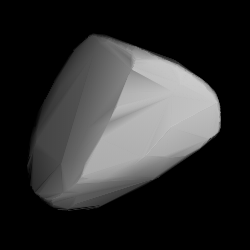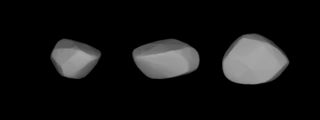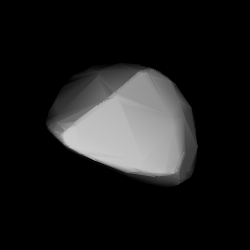
Erna, provisional designation 1895 CB, is a dark asteroid of the background population in the outer regions of the asteroid belt, approximately 46 kilometers in diameter. It was discovered by French astronomer Auguste Charlois at Nice Observatory on 22 August 1895. The asteroid was presumably named after Erna Bidschof, the granddaughter of Johann Palisa.
606 Brangäne, provisional designation 1906 VB, is an asteroid from the central regions of the asteroid belt, approximately 36 kilometers in diameter. It was discovered on 18 September 1906, by astronomer August Kopff at the Heidelberg Observatory in southwest Germany. The unusual K-type asteroid is the namesake of the small Brangäne family and has a rotation period of 12.3 hours. It was named after Brangaine, a character from the opera Tristan und Isolde by Richard Wagner.
2009 Voloshina, provisional designation 1968 UL, is a carbonaceous asteroid from the outer regions of the asteroid belt, approximately 27 kilometers in diameter.

1010 Marlene is a carbonaceous background asteroid from the outer regions of the asteroid belt, approximately 47 kilometers in diameter. It was discovered on 12 November 1923, by astronomer Karl Reinmuth at the Heidelberg-Königstuhl State Observatory in southwest Germany. The asteroid was named after German actress and singer Marlene Dietrich.
1085 Amaryllis, provisional designation 1927 QH, is a background asteroid from the outer regions of the asteroid belt, approximately 69 kilometers in diameter. It was discovered on 31 August 1927, by astronomer Karl Reinmuth at the Heidelberg-Königstuhl State Observatory in southwest Germany. The asteroid was named after the flowering planet Amaryllis.

1129 Neujmina is an Eos asteroid from the outer regions of the asteroid belt. It was discovered on 8 August 1929, by astronomer Praskoviya Parchomenko at the Simeiz Observatory on the Crimean peninsula. The stony S-type asteroid has a rotation period of 5.1 hours and measures approximately 34 kilometers in diameter. It was named after Soviet astronomer Grigory Neujmin.
3037 Alku, provisional designation 1944 BA, is a carbonaceous asteroid from the central region of the asteroid belt, approximately 20 kilometers in diameter. It was discovered on 17 January 1944, by Finnish astronomer Yrjö Väisälä at Turku Observatory in Southwest Finland.
1354 Botha, provisional designation 1935 GK, is an exceptionally dark background asteroid from the outer regions of the asteroid belt, approximately 46 kilometers in diameter. It was discovered on 3 April 1935, by South-African astronomer Cyril Jackson at the Union Observatory in Johannesburg. The asteroid was named after South African prime minister Louis Botha.
1215 Boyer, provisional designation 1932 BA, is a stony Eunomian asteroid from the central region of the asteroid belt, approximately 20 kilometers in diameter. It was discovered by astronomer Alfred Schmitt in 1932, who named it after French astronomer and college Louis Boyer.
1295 Deflotte, provisional designation 1933 WD, is a carbonaceous asteroid from the outer regions of the asteroid belt, approximately 48 kilometers in diameter. It was discovered on 25 November 1933, by French astronomer Louis Boyer at the Algiers Observatory in Algeria, North Africa. The asteroid was named after the discoverer's nephew.

1241 Dysona, provisional designation 1932 EB1, is a dark background asteroid from the outer regions of the asteroid belt, approximately 77 kilometers in diameter. It was discovered on 4 March 1932, by English astronomer Harry Edwin Wood at the Union Observatory in Johannesburg, South Africa. The asteroid was named after English astronomer Frank Watson Dyson.

1540 Kevola, provisional designation 1938 WK, is a dark background asteroid from the outer regions of the asteroid belt, approximately 42 kilometers in diameter. It was discovered on 16 November 1938, by astronomer Liisi Oterma at the Iso-Heikkilä Observatory in Turku, Finland. The asteroid was named after the Finnish Kevola Observatory.

1436 Salonta, provisional designation 1936 YA, is a dark background asteroid from the outer regions of the asteroid belt, approximately 60 kilometers in diameter. Discovered by György Kulin at the Konkoly Observatory in 1936, the asteroid was later named for the Romanian city of Salonta, the birthplace of the discoverer.
1258 Sicilia, provisional designation 1932 PG, is a dark background asteroid from the outer regions of the asteroid belt, approximately 44 kilometers in diameter. It was discovered on 8 August 1932, by astronomer Karl Reinmuth at the Heidelberg-Königstuhl State Observatory in southwest Germany. The asteroid was named after the Italian island of Sicily.

1493 Sigrid, provisional designation 1938 QB, is a dark Nysian asteroid from the inner regions of the asteroid belt, approximately 24 kilometers in diameter. It was discovered on 26 August 1938, by Belgian astronomer Eugène Delporte at the Royal Observatory of Belgium in Uccle. It was named after Sigrid Strömgren, wife of astronomer Bengt Strömgren.
1585 Union, provisional designation 1947 RG, is a dark background asteroid from the outer regions of the asteroid belt, approximately 52 kilometers in diameter. It was discovered on 7 September 1947, by South African astronomer Ernest Johnson at the Union Observatory in Johannesburg, South Africa. The asteroid was named after the discovering observatory.
1242 Zambesia is a dark background asteroid from the central regions of the asteroid belt, approximately 48 kilometers in diameter. It was discovered on 28 April 1932, by South African astronomer Cyril Jackson at the Union Observatory in Johannesburg. The asteroid was named for the large Zambezi basin in southern Africa.

1407 Lindelöf, provisional designation 1936 WC, is an asteroid from the central region of the asteroid belt, approximately 20 kilometers in diameter. It was discovered on 21 November 1936, by Finnish astronomer Yrjö Väisälä at Turku Observatory in Southwest Finland. The asteroid was named after Finnish topologist Ernst Lindelöf.
1708 Pólit, provisional designation 1929 XA, is a very dark asteroid from the outer region of the asteroid belt, approximately 29 kilometers in diameter. It was discovered on 30 November 1929, by Spanish astronomer of Catalan origin Josep Comas i Solà at the Fabra Observatory in Barcelona, and was later named after Catalan astronomer Isidre Pòlit i Boixareu.
1724 Vladimir, provisional designation 1932 DC, is a rare-type asteroid from the central region of the asteroid belt, approximately 35 kilometers in diameter. It was discovered on 28 February 1932, by Belgian astronomer Eugène Delporte at the Royal Observatory of Belgium in Uccle, Belgium. The asteroid was later named by astronomer Milorad Protić after his grandson, Vladimir.








